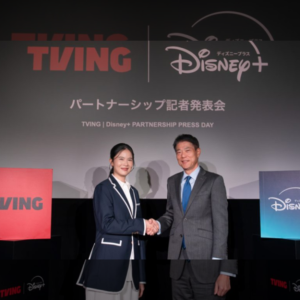Content Report analyzes culturally significant content with a fresh perspective while investigating the current state of K-culture and the cultural industry.
It is a feeling familiar to us all: the moment we get hooked on a new show. Whether we are white-knuckled with excitement at the climax of a thrilling episode or perched quietly on the edges of our seats, captivated by the machinations of an immersive, slow-burning plot, there’s nothing quite like getting snared by a new set of characters and situations.
With the development and sky-rocketing popularity of Over-the-Top (OTT) video streaming services – services that offer the streaming of their content directly over the internet – we can now access, and get gripped by, shows from all over the world, anytime and anywhere.
However, in some ways all this variety can leave us feeling, strangely, a little cold or distant. There is so much to watch, but within this huge variety there are only a few shows that are directly relevant to our daily lives and our experiences of the world. Personalized algorithms are supposed to address this problem by matching suggestions to our tastes on OTT services, but they don’t always feel like they give us a true distillation of our preferences.
Now, however, there are forms of content that are growing rapidly to fill this void, and the recent surge of native OTT platforms demonstrates this. This will allow viewers to get the best of both worlds by experiencing both refreshing, exotic new shows from all around the world and content that feels a bit closer to home and therefore more comforting and accessible. Korean OTTs offer a prime example of how these services are evolving to fully satisfy domestic audiences.
The Continued Success of Korean OTT ‘TVING’

This surge of interest in Korean content within the Korean domestic market is interesting because for some time now native OTT platforms have struggled to compete with global service providers. This began in Korea in 2016, when Netflix entered the domestic market and the issue has only been compounded by the expansion of other big players like Disney+ and Apple TV+ into local markets.
However, despite these challenging developments, recent years have turned up unexpected twists. Despite the domination of bigger platforms, domestic OTTs have seen significant increases in subscriber numbers. To look at a specific example, last December it was found that the number of Korean streaming service TVING’s paid subscribers had increased by 256% when compared to the same period the previous year, and according to Mobile Index, the Monthly Active User (MAU) number of TVING increased by 50% from January to November last year. This, tellingly, is the highest growth rate among other OTT platforms, with Netflix growing by 26% and Wavve by 9% during the same January to November period.
More significant than these figures, though, are the emotional responses of audiences. Word of mouth has helped shows like ‘EXchange’, ‘Work Later, Drink Now’, ‘Yumi’s Cells’ and ‘High School Mystery Club’ go viral fast, bringing many new subscribers to TVING in the process. Cases like this show that even if a show is not a household name worldwide supported by a huge budget, it can still build serious momentum if the quality is high enough and it resonates with impassioned audiences.
Platforms and Content That Understand Their Korean Audiences

The key to TVING’s rapid growth rate, though, is K-content’s focus on authenticity. As a fierce battle to secure K-content plays out worldwide, including in Hollywood, Hallyu fever – also known as the Korean Wave – continues to spread. However, tracing the roots of K-content always leads back to the same place: the key players in the development of the domestic Korean content market and the host of content creators who have long been pitching fresh ideas and shows to major Korean TV channels, like tvN and OCN.
Creators like this have strived to make quality content for Koreans, by Koreans. As this formula has been tightened up over the years, beloved shows that speak to the emotions and daily lives of Koreans have arrived one after another and, from this strong base, the wider momentum of K-wave began to grow. TVING has accumulated more than 60 original and exclusive shows since the launch of its service thanks to the strength of this foundation, and the platform has become synonymous with many of K-content’s biggest success stories.
TVING’s intuition for generational tastes is also an important factor, particularly with the 20s to 30s age range, which is the main audience for OTTs. Generation MZ, as this demographic is known in Korea, tends to favor content that is uplifting, relatable and emotionally sensitive. The aforementioned ‘EXchange’ and ‘Work Later, Drink Now’ cater to precisely these MZ preferences, and reviews reflect as much. Similarly, CJ ENM’s extensive experience in creating and broadcasting shows via tvN and OCN has played a key role. TVING has been working hard to present more youthful and emotionally lively content than is offered by existing terrestrial broadcasting channels and as a result it is now more than capable of providing original content built to appeal to younger people on their own OTT platform.
Expandability Through Authenticity

Of course, any new model has obstacles to overcome. In order for native OTT platforms like TVING to compete with their global equivalents, they need to develop their expandability. This necessitates the reworking of local platforms as global OTTs, so that their content can be accessed and enjoyed by people regardless of region or generation.
TVING is even seeking out opportunities overseas, and their competitive edge might come from the very authenticity about the Korean experience that has been such a big hit with domestic Korean audiences. While global platforms’ traditional output might not align exactly with the structure of traditional Korean content, Hallyu fever – which reached a paradigm-shifting milestone when Joon Ho Bong’s ‘Parasite’ won the Academy Award for Best Picture in 2020 – has caught the attention of and subsequently entranced audiences all over the globe and continues to do so.
By working together with CJ ENM and taking advantage of its long established and ever-growing connections with global markets, TVING is expected to continue to build and diversify its content with an eye to winning over more audiences abroad.
When looking for a new place to dine out, we usually try looking all over the place first. We try all the fancy and famous restaurants, but, inevitably, we end up seeking out the authentic experience, the original, the place the dish we want was first cooked up, where the food has a flavor to it that cannot be easily mimicked by other establishments.
We can think of content somewhat like this, too. Despite the heft and the glamor of international OTTs platforms, there is no denying the lasting power and the enduring popularity of earnest shows that do something new with time-tested formats, and the world of Korean entertainment is no exception.












